Streptavidin-TRITC

-
Übersicht
Artikelnummer 016-020-084 Protein Anwendung Bio Assay, Durchflusszytometrie (Flow Cytometry), ELISA (Enzyme Linked Immunosorbent Assay), Immuncytochemie, Immunfluoreszenz, Immunhistochemie (Gefrierschnitte), Immunhistochemie (IHC), Immunhistochemie (Paraffingewebe), Immunpräzipitation, Western Blot
Konjugation Maximale Anregung Maximale Emission Format 0,05% NaN3, 15 mg/ml BSA (IgG- und Protease-frei), in PBS (pH 7,6), Lyophilisat
Verdünnung Durchflusszytometrie 2 – 5 µg/ml, Histo-/Zytochemie 2 – 5 µg/ml
Zweckbestimmung Hersteller / Marke - Datenblätter und Downloads
-
Weitere Produktinformationen
Reactivity
Antibody clone SZ31 is the first antibody which reacts specifically with murine CD31 in formalin-fixed paraffin-embedded tissue sections.
CD31, also known as PECAM-1 (Platelet Endothelial Cell Adhesion Molecule-1) is expressed constitutively on the surface of embryonic and adult endothelial cells. It is also expressed on cell surfaces of monocytes, neutrophils, platelets and certain T-cell subsets. It has been detected on bone marrow-derived hematopoetic stem cells and embryonic stem cells. CD31 is a 130kDa integral membrane glycoprotein and as a member of the immunoglobulin superfamily involved in the mediation of cell-to-cell adhesion. CD31-mediated endothelial cell-cell interactions play a major role in angiogenesis. Studies have shown CD31 to be a superior marker in human angiogenesis, which reportedly predicts tumor recurrence. Pathophysiological studies of CD31 in murine model systems had limitations because standard formalin-fixed sections were excluded. The clone SZ31 eliminates these restrictions by allowing high quality immunohistochemical analysis of standard formalin-fixed paraffin sections in mice.Immunohistochemistry of mouse CD31 (PECAM-1) in formalin-fixed paraffin-embedded tissue sections
The monoclonal antibody clone SZ31 reacts specifically with endothelial cells in vessels and capillaries of:
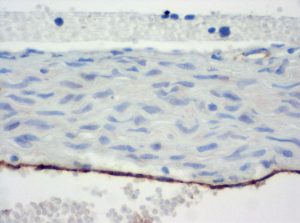
aorta
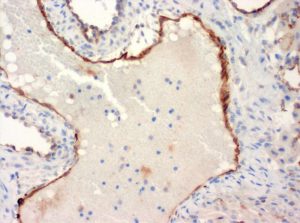
aortic origin
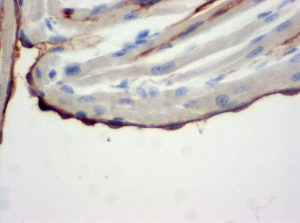
endocardium
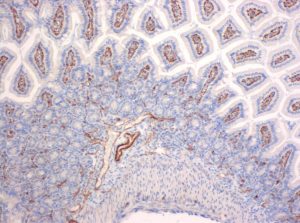
small intestine
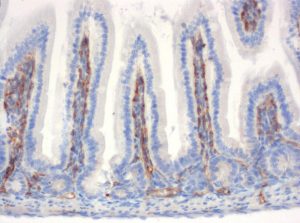
small intestine
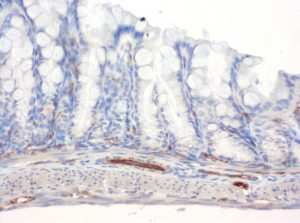
colon
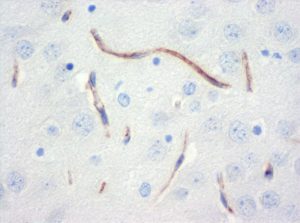
brain
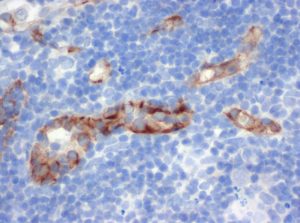
lymph nodes
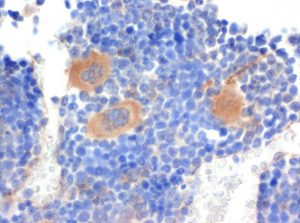
bone marrow

mesenterial vessels
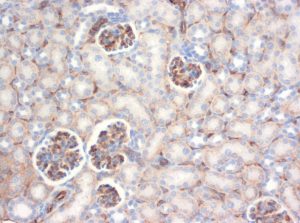
kidney
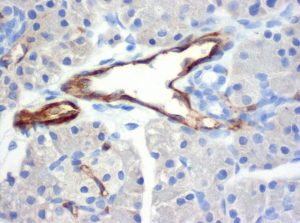
pancreas
(pictures courtesy of Prof. Dr. Robert Klopfleisch, Institute of Pathology, Department of Veterinary Pathology, Berlin, Germany)
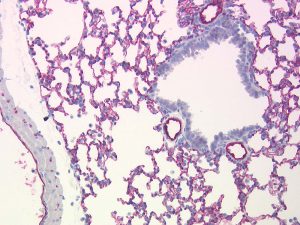
Lung
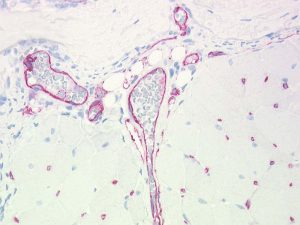
Muscle
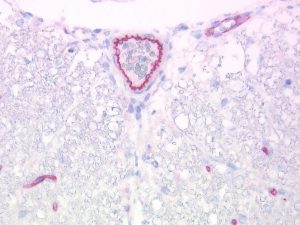
Spinal
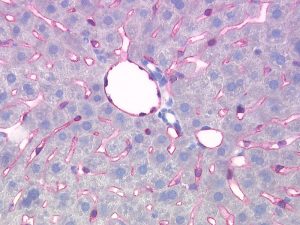
Liver
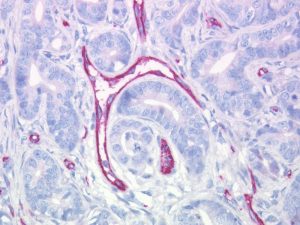
Adenocarcinoma
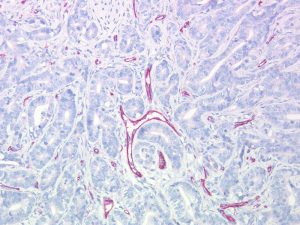
Adenocarcinoma
(pictures courtesy of Prof.Dr.H.Stein, Institute of Pathology, Charité Campus Benjamin Franklin, Berlin, Germany)
Western blot analysis
Immunoblot of extracts from murine lung, J558L cells and m-Lend cells using CD31 rat monoclonal antibody clone SZ31 (DIA-310 1:5.000) and goat anti-rat-HRP antibody (1:10.000).
Lane:
- J558 cells (CD31-), 25μg lysate
- murine lung, 25μg lysate
- blank
- m-Lend cells (CD31+), 12.5μg lysate
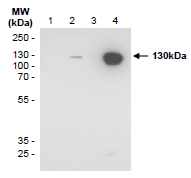
References
- Hölscher M, Silter M, Krull S, von Ahlen M, Hesse A, Schwartz P, Wielockx B, Breier G, Katschinski DM, Zieseniss A.
Cardiomyocyte-specific prolyl-4-hydroxylase domain 2 knock out protects from acute myocardial ischemic injury.
J.Biol.Chem. 286: 11185-11194, 2011 - Kröger C, Vijayaraj P, Reuter U, Windoffer R, Simmons D, Heukamp L, Leube R, Magin TM. Placental vasculogenesis is
regulated by keratin-mediated hyperoxia in murine decidual tissues. Am.J.Pathol. 178(4): 1587-1590, 2011 - Jiang J, Thyagarajan-Sahu A, Krchnák V, Jedinak A, Sandusky GE, et al. NAHA, a Novel Hydroxamic Acid-Derivative,
Inhibits Growth and Angiogenesis of Breast Cancer In Vitro and In Vivo. PLoS ONE 7(3): e34283, 2012 - Copeland BT, Bowman MJ, Ashman LK. Genetic Ablation of the Tetraspanin CD151 Reduces Spontaneous Metastatic
Spread of Prostate Cancer in the TRAMP Model. Mol Cancer Res. 11(1):95-105, 2013 - Agliano A, Martin-Padura I, Marighetti P, Gregato G, Calleri A, Prior C, Redrado M, Calvo A, Bertolini F. Therapeutic effect
of lenalidomide in a novel xenograft mouse model of human blastic NK cell lymphoma/blastic plasmacytoid dendritic
cell neoplasm. Clin Cancer Res. 1;17(19):6163-73, 2011 - Ferretti E, Montagna D, Di Carlo E, Cocco C, Ribatti D, Ognio E, Sorrentino C, Lisini D, Bertaina A, Locatelli F, Pistoia V,
Airoldi I. Absence of IL-12Rβ2 in CD33(+)CD38(+) pediatric acute myeloid leukemia cells favours progression in
NOD/SCID/IL2RϒC-deficient mice. Leukemia 26(2):225-35,2012
